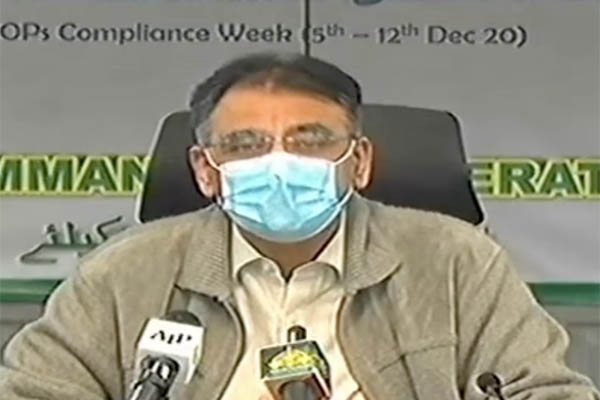
Planning Minister Asad Umar. Youtube
Citing Pakistan Bureau of Statistics survey, planning minister says 27.31 million of country’s working population was affected by lockdown restrictions
Reiterating calls for the public to continue adopting preventative measures to curb the spread of the novel coronavirus, Planning Minister Asad Umar on Tuesday said the government’s strategy had ensured the protection of lives and livelihoods.
Addressing media in Islamabad, he unveiled the results of a survey conducted the Pakistan Bureau of Statistics, highlighting the impact of the first wave of COVID-19 on Pakistan’s economy. According to the report—made public last week—27.31 million of the country’s “working population” of people aged 10 and above were impacted between April and July 2020.
The survey was conducted between Oct. 20 and Nov. 5, and comprised data of 500 blocks covering 6,000 households. According to the Bureau, 70 percent of the sample was taken from urban areas, while 30 percent from rural areas, reflecting the greater impact of lockdown restrictions in the urban sector. It divided the time examined into three categories: pre-COVID (January to March); during COVID (April to July); and post-COVID (August to Nov. 5).
According to the survey, 55.74 million people 10 years and older—35 percent of the population—were economically active prior to the COVID-19 pandemic. It said this had declined to 22 percent—35.04 million people—due to the lockdown restrictions imposed to curb the spread of the virus. The worst-hit province was Sindh, whose working population reduced from 38 percent pre-COVID to 23 percent during. This was followed by Punjab with a 14 percent decline, and Balochistan with an 11 percent decline.
The worst-hit sector was manufacturing, with 26 percent of survey respondents saying they had suffered loss or reduction in income during the first wave of COVID-19. This was followed by construction at 20 percent; transport and storage at 17 percent; wholesale and retail at 16 percent; and services at 11 percent. A majority of the respondents, 54 percent, said they had reduced non-food expenses in response to the pandemic’s effects. Meanwhile, 50 percent said they had switched to lower quality or quantity of food, while 47 percent said they had dipped into their savings and 30 percent said they had sought loans from friends or relatives.
“The livelihood of 17.07 million Households [was] affected due to lockdown restrictions, [with] evidence suggesting that if strict lockdown had continued, devastating Impacts may have been observed on the livelihoods of vulnerable groups of workers and their families,” read the report. However, it said, the country’s economy had shown almost a “V shape” recovery from August to October 2020.
In his press conference, Umar lauded Prime Minister Imran Khan’s decisions in securing both lives and livelihoods. “Since the first day, the prime minister told us we have two responsibilities: to work to save the lives of the people and to save their jobs,” he said, noting the strategy had been lauded by several international organizations.
However, warned Umar, the threat was not yet over. He said some countries were now even seeing a third wave of COVID-19, and urged the public to continue practicing standard operating procedures to contain the spread of the virus.
